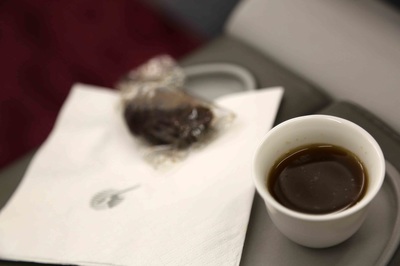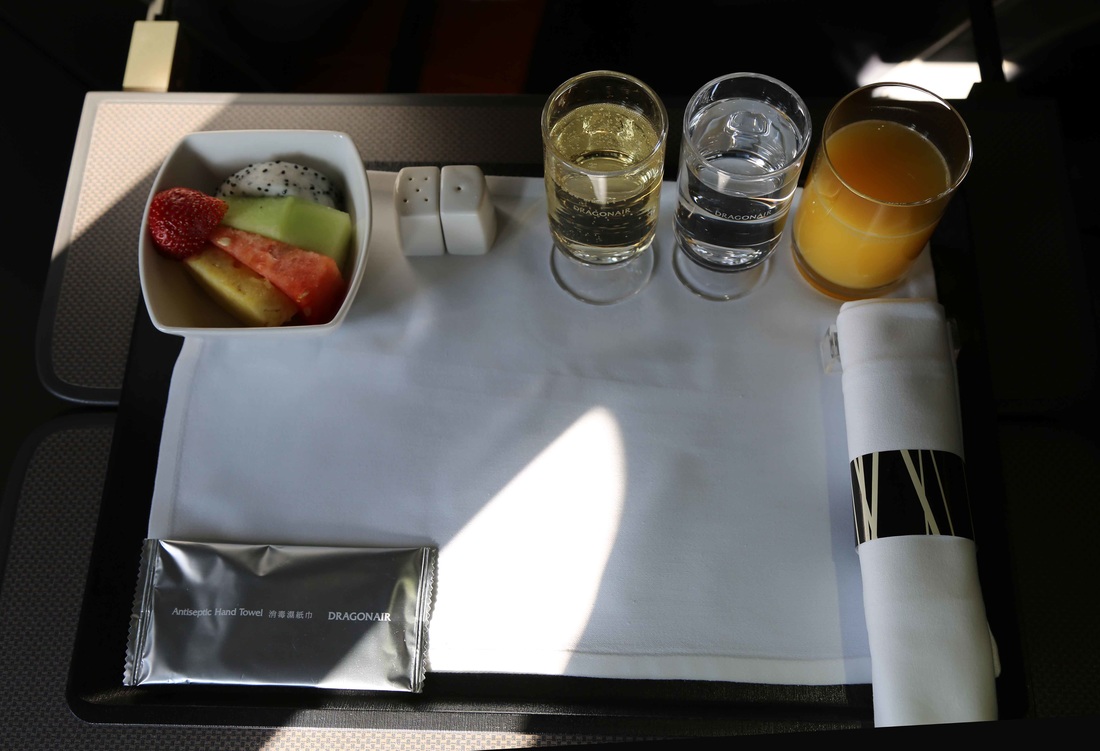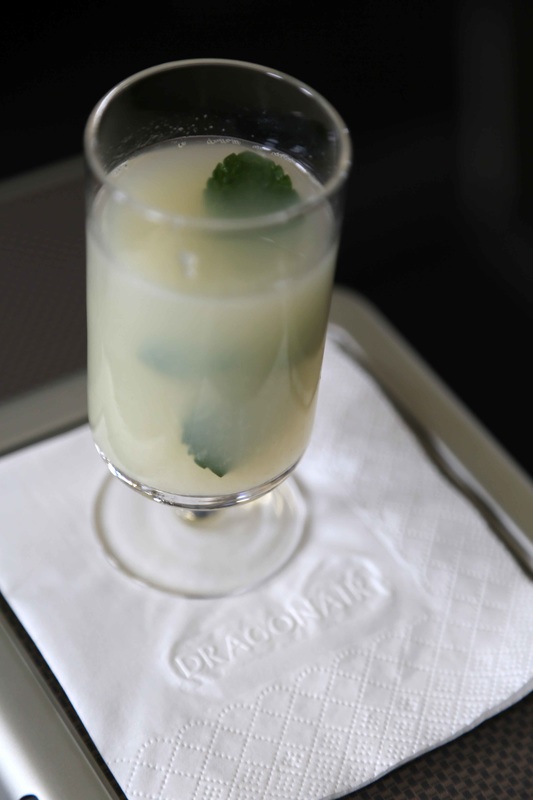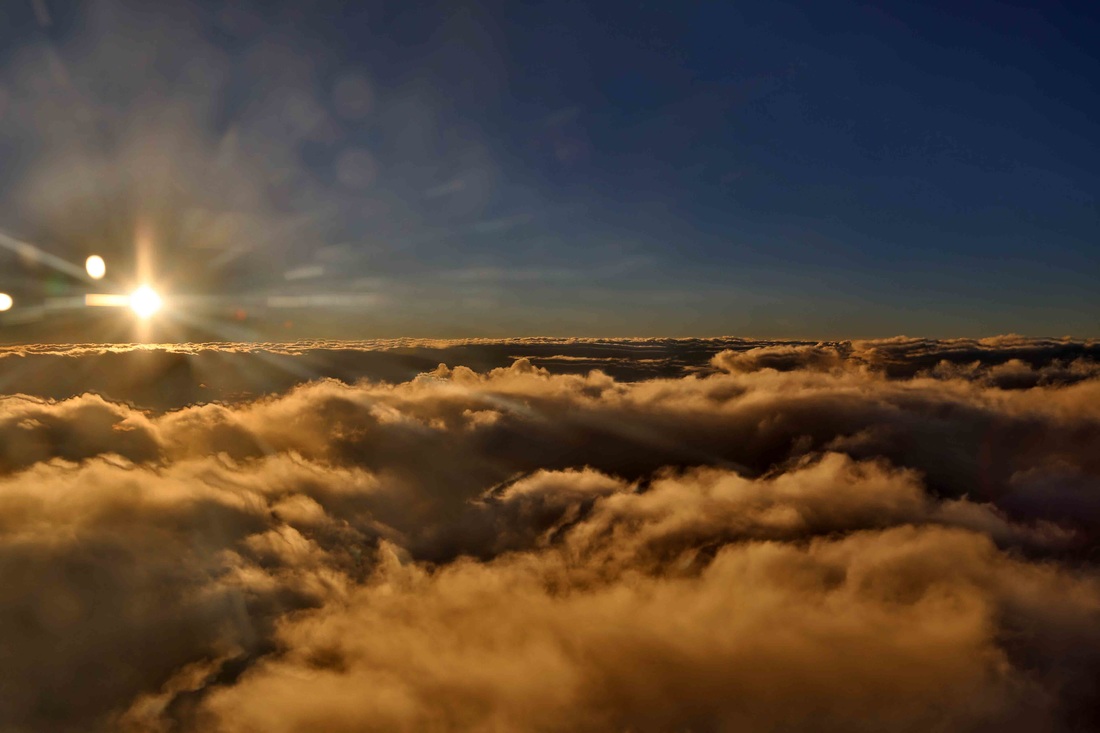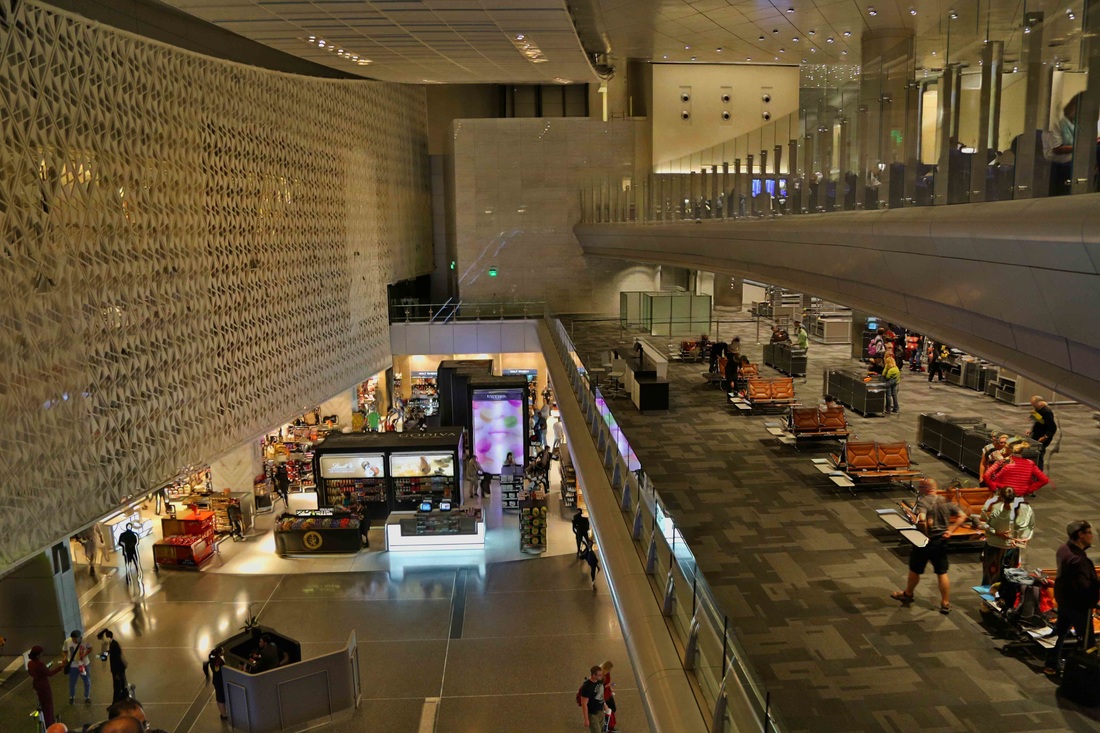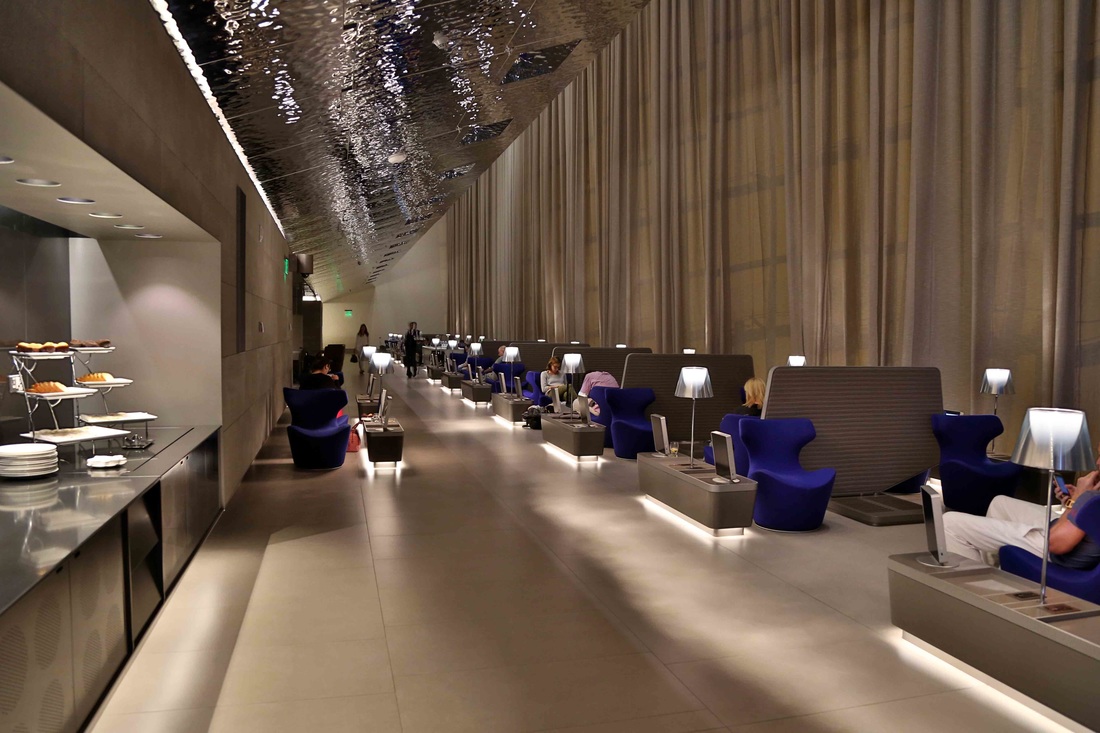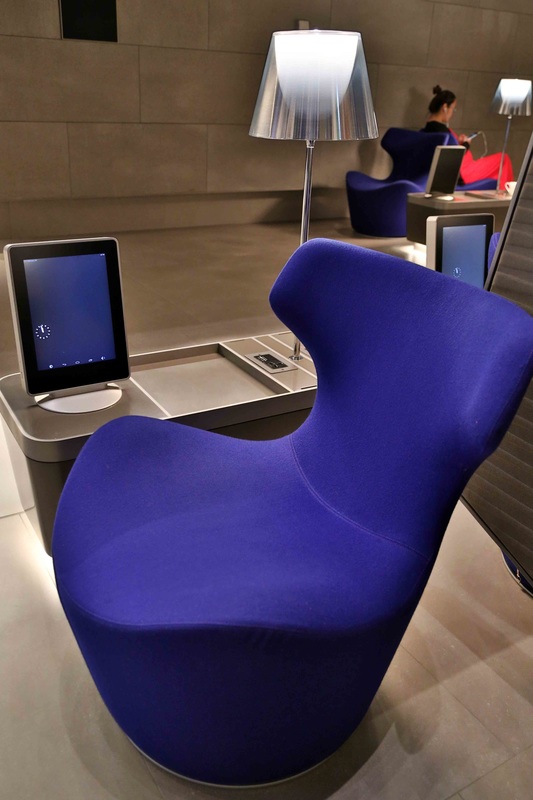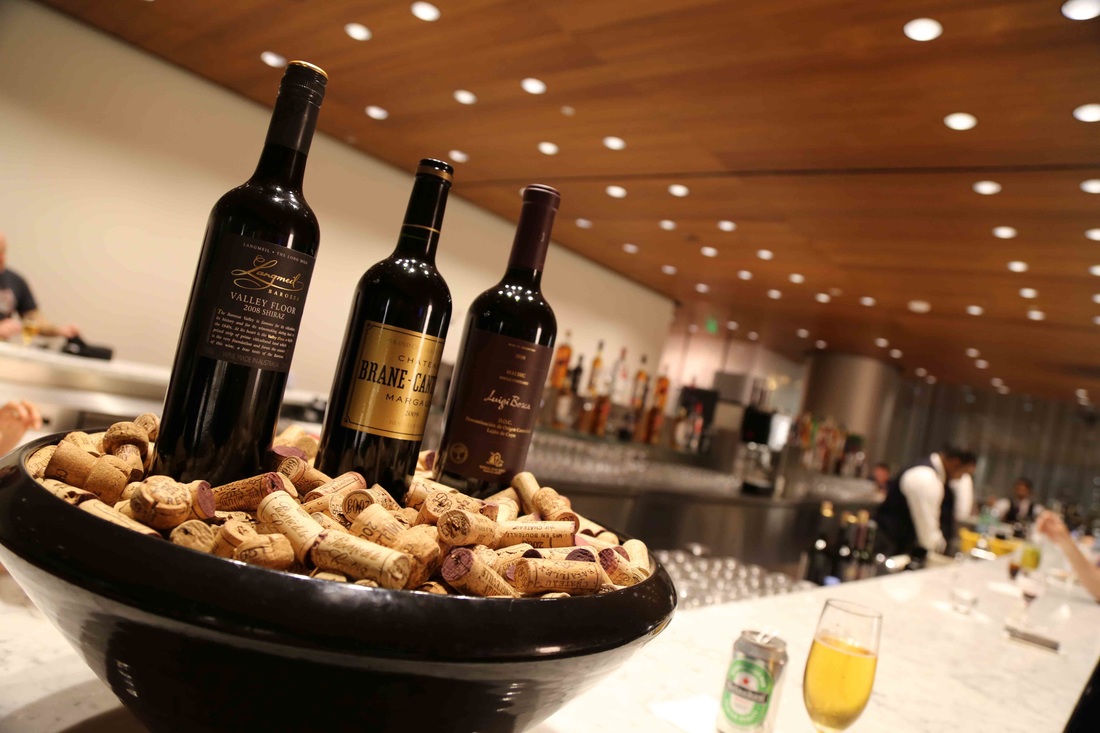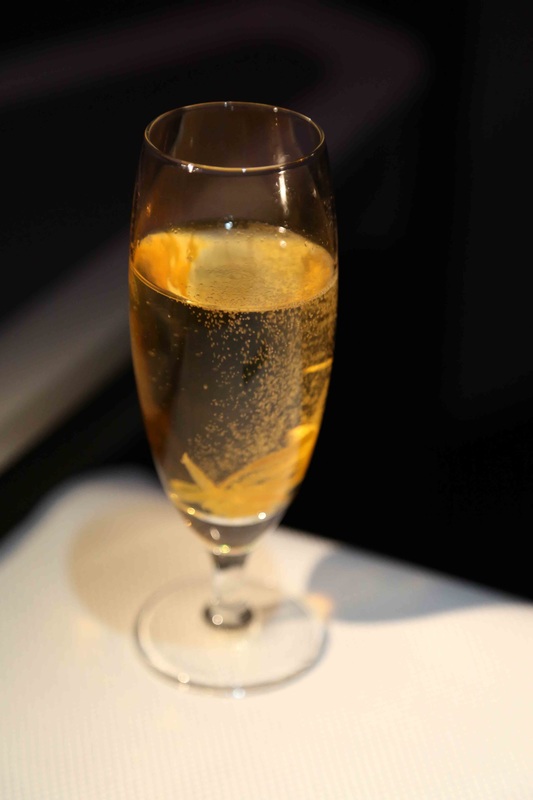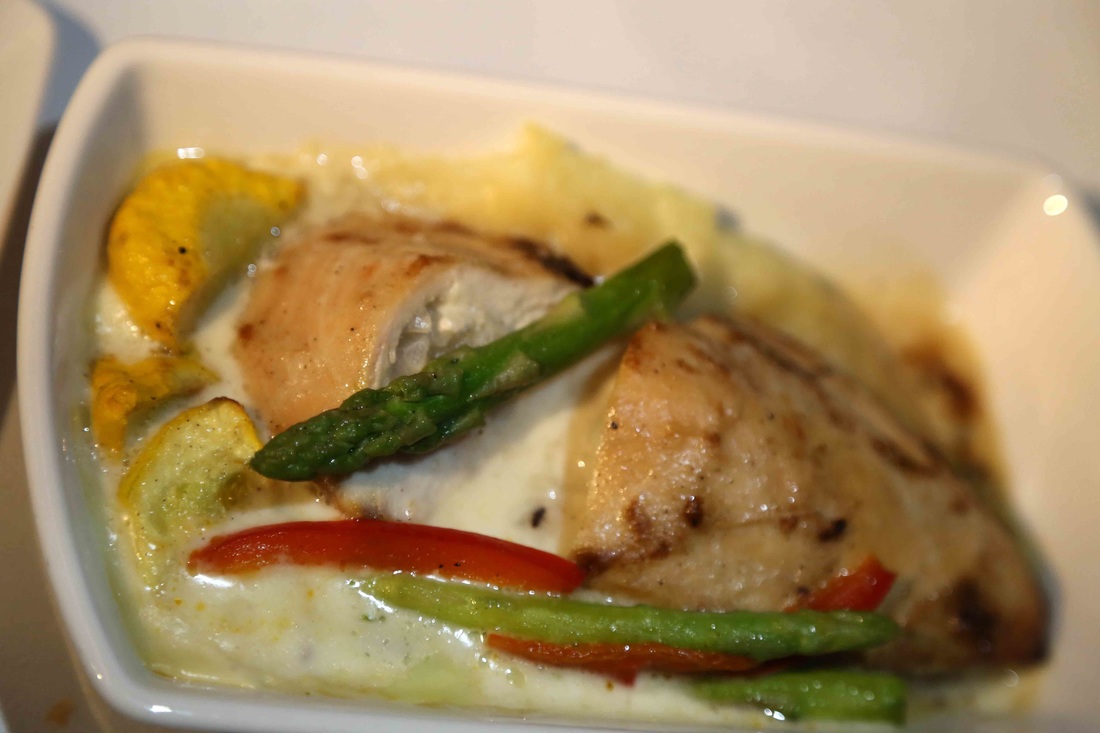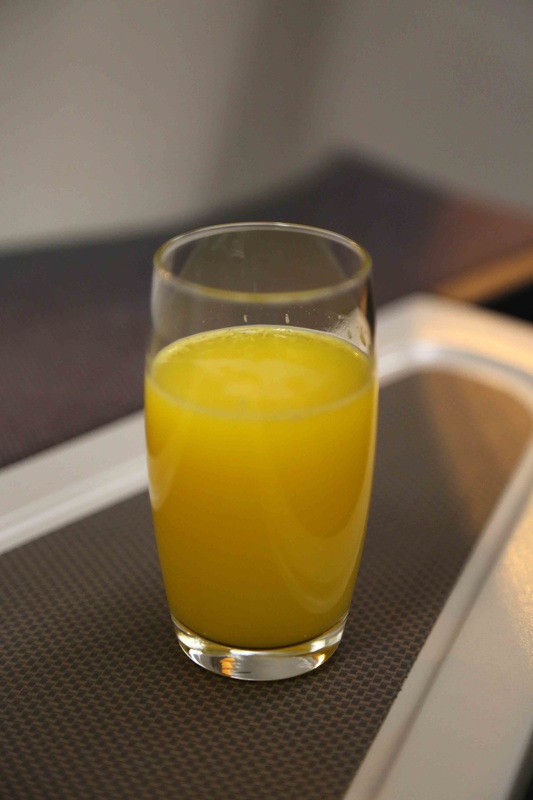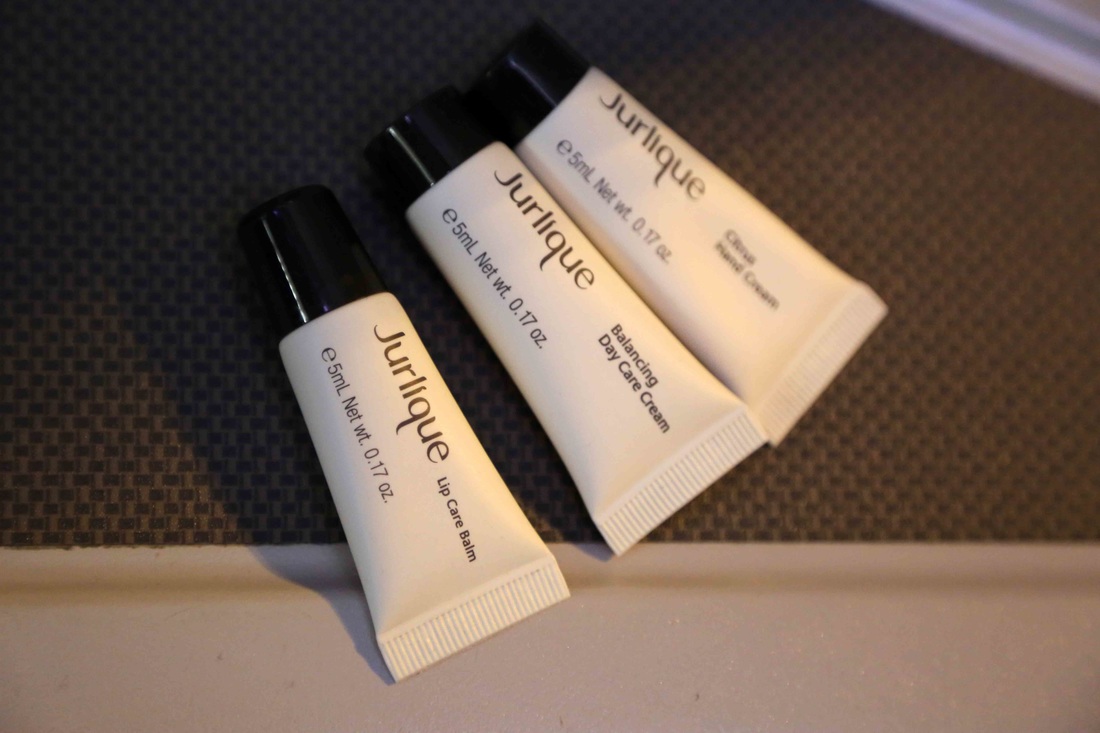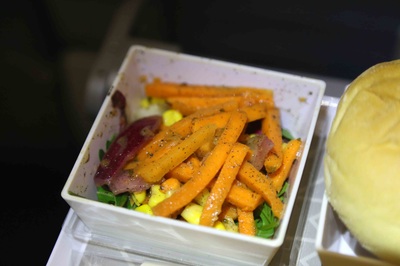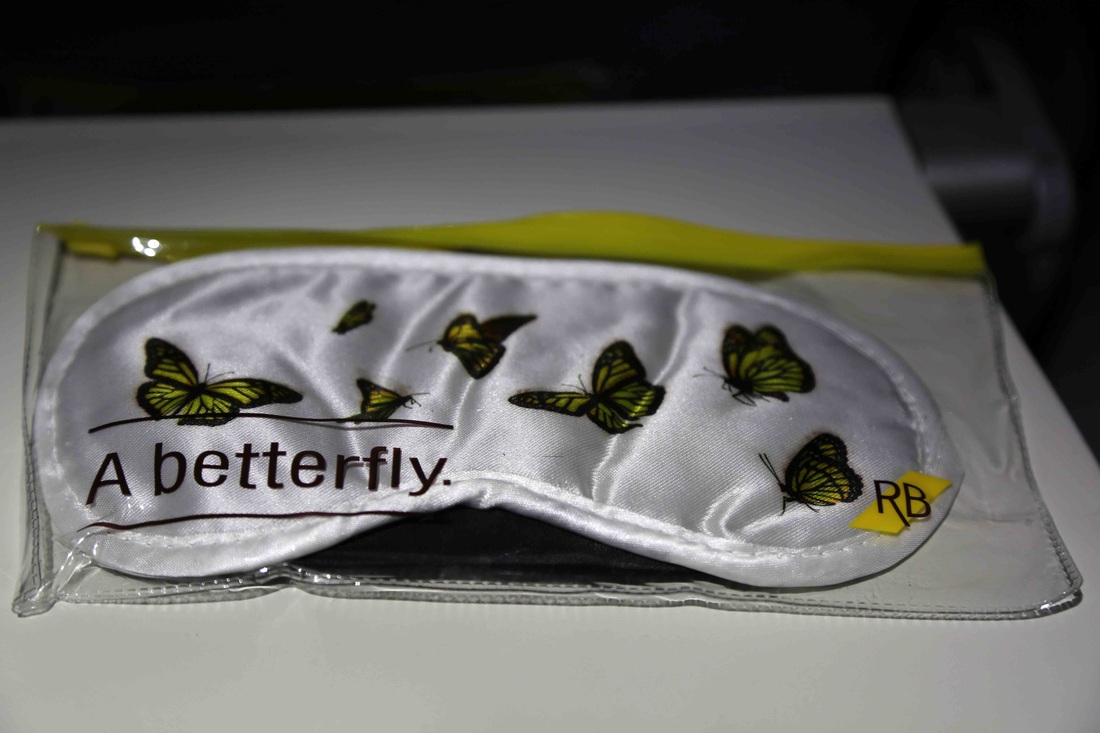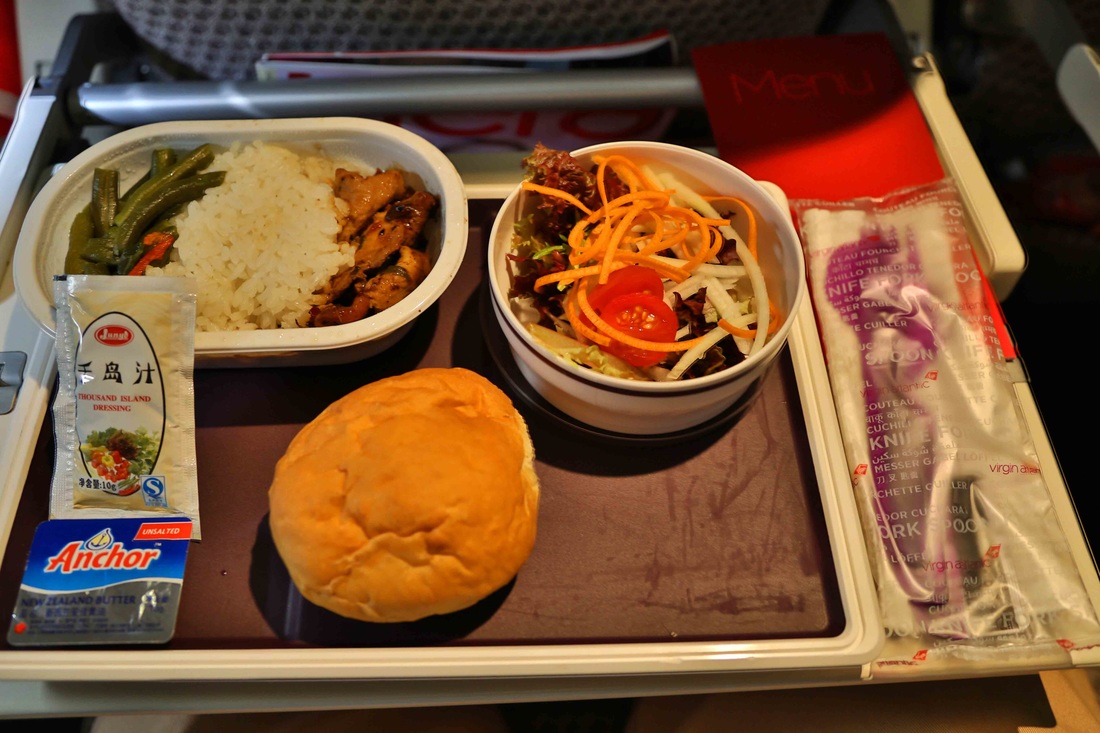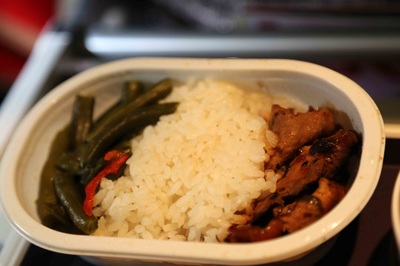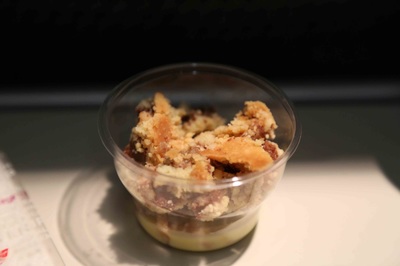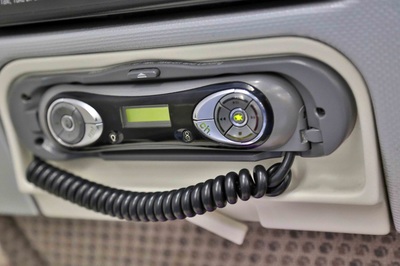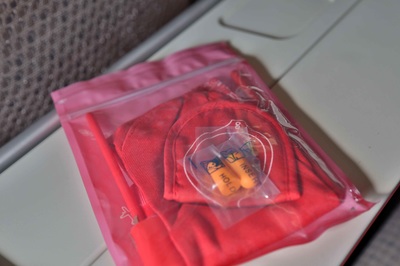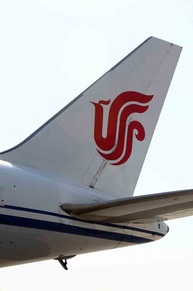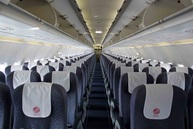QATAR AIRWAYS (Dubai Intl. Airport (DXB) to Doha Hamad Intl. Airport), AIRBUS A320, FIRST CLASS2/15/2015
Qatar Airways (القطرية) is the national flag carrier of the State of Qatar (دولة قطر) in the Middle East. Founded on the 22nd of November 1993, the airline has gone through a rapid expansion in a short time span to serve 151 destinations using 167 state-of-the-art modern, and young aircraft. The airline, which employees a total of around 20,000 people world-wide, is based in the ultra-modern Doha Control Tower at Doha International Airport and serves its destinations across Europe, Middle East, Africa, Australasia, the Indian subcontinent, and East Asia. The airline is the proud holder of a number of awards. As the focused industrialist CEO of Qatar Airways, Akbar Al Baker, says: ‘Travel by air has reached the point where it is now taken for granted in most corners of the globe. With a larger number of passengers and more choice available in the skies today, airlines looking to maintain or grow their position in the marketplace must provide high-quality service with ever-increasing efficiency.’ Mr. Akbar is one of the most influential leaders in the aviation industry. The man lives, breaths, sleeps not just for Qatar Airways, but for Qatar as a whole. It’s because of his deep passion and drive for excellence that Qatar Airways is one of the best airlines in the world. He’s well-known in the industry for this strong drive for results- very enthusiastic person. Personally, I don’t think Qatar Airways should be a member of any airline alliance because they have a class of their own. It is no match to any other airline I have been on. Alliances may the future for other airlines as a way of survival in the aviation industry, but I don’t think Qatar Airways should be with OneWorld or any other alliance. It just lowers the brand image (my opinion). Etihad Airways has partnered with India’s Jet Airways (not good in my opinion) and Emirates has partnered with Qantas (again…Emirates was better off by themselves). In January 2015, the airline concluded an order for four Boeing 777Fs in a deal worth US$1.24 billion; Qatar Airways also took purchase rights on four more aircraft of the type. In June 2015, it was disclosed Qatar Airways ordered ten Boeing 777-8Xs and four additional Boeing 777Fs for USD 4.18 billion. The Airbus A320 aircraft is used for regional routes around the Eastern Europe, Middle East, Africa, and to South Asian routes. I took this flight as part of a package, flying from Dubai’s brand new airport (Dubai Al Maktoum Intl. Airport- DWC) to Hong Kong, via a stopover and change of airline and flight at Doha Hamad Intl. The new DWC airport is located on the outskirts of Dubai, around a 30-minute taxi ride from the downtown. It is in the middle of a desert near Jabel Ali. Route: DUBAI AL MAKTOUM INTERNATIONAL (DWC) to DOHA (DOH) Departure date and time of flight: February 2015, 23:35 Flight number: QR1035 (ICAO callsign: “Qatari 1035”) Flight duration: 55 minutes Cabin: FIRST CLASS Aircraft type: AIRBUS A320-232 (31 in service) Unit cost of each Airbus A320: US$97.0 (€92.0) million (2015) Aircraft registration: A7-ADJ (First flight 16 September 2004) Engine Type: Two x IAE V2527-A5 Aircraft Serial Number: 2288 Aircraft Name: Al Samriya Frequent flyer programme: Qatar Airways' Privilege Club- Q Miles Seat configuration for this aircraft: First Class: 12 seats in a 2-2 configuration Economy Class: 132 seats in a 3-3 configuration Any baggage issues: No issues regarding the baggage. For First and Business Class Qatar Airways have a checked baggage allowance of 40 kg and 30 kg total respectively for all routes excluding transatlantic routes. Therefore, for the Dubai to Doha route, they have a 30 kg luggage policy. All routes have a carry-on allowance of one piece not exceeding 7 kg (50x37x25 cm). Comments on the check-in: I arrived around two hours early for check-in. I was the only passenger flying in First Class on this flight, which meant the 12 seats all for myself! It was interesting to see that on another flight, four Arab chaps carried a falcon each. They told me that each Falcon is prized at around US$1.5 million. In the Middle East (Dubai Airport here), even Falcons (the national bird of most of the ME countries) get to travel in First Class! They had the whole First Class cabin for themselves on that flight...all 18 seats booked for just four people and their birds. P.S. airlines only need to fill all First Class and Business Class seats in order to break even for a flight (Economy Class is just extra profit...so even if Economy Class is full, the airline will most likely not break-even for the flight if the First Class/Business Class are empty/not fully booked)...so, airlines need people like these rich travellers. They can fly up to 300 km/h and can spot food from around 12,000 feet in the air....smart bird. The new airport is practically empty. Only a handful of flights go from here, at the time of writing. Qatar Airways Lounge at Dubai World Airport The Qatar Airways lounge is located after security on the second floor. The lounge experience was pleasant, enjoyable and quiet, as it should be, until the loud, boisterous and drunk members of the Qatar Rugby team entered the lounge. Their captain was the worst culprit of all, as he encouraged the lads to (I quote): “help yourselves to the free food and alcohol while it lasts”. Most of the young men appeared to be British (from their accents), and these were men, not teenagers or kids. If these guys are representing Qatar and behaving like chavs in an international airport First Class lounge, then there is a serious issue and problem that Qatar needs to deal with (these guys were flying Economy Class, but had access to the lounge because they had collected the air miles). It’s a serious image problem to say the least. At first I thought they were a bunch of hooligans who had perhaps come a football match and were on a stopover in Dubai. I was quite shocked and disappointed when I learned that they were professional rugby players representing the Qatar national team. Seriously, these guys were behaving as if they’ve never seen food before, and because it was free, so they were drinking alcohol like fish and eating with their mouths open. They had no manners. If anything, it turned out to become one of the worst lounge experiences ever. It wasn’t just me, but others in the lounge also complained, too. I am sure if the CEO of Qatar Airways, Akbad Al Baker, was in the lounge, he would have had a word with them. Punctuality of the flight: Departed bang on time, however we landed around 15 minutes late due to the air traffic at Doha. The new Hamad airport has two runways and so it can get busy during the airlines peak hours (which are at night time). Time is money when it comes to the aviation industry as fuel costs, combined with landing fees, take-off slot fees, and airport management fees pile on rapidly the longer the aircraft stays on the ground. Qatar Airways, and the ground-handling agents at Dubai are very efficient in what they do and how they operate on time. The captain had plenty of fuel in the tanks in case we had to do a fuel dumping (god forbid!), and everything was well managed for this flight. Once we arrived in Doha, I had two hours to enjoy in the huge lounge before I had to catch my connecting flight to Hong Kong (with Cathay Pacific Airways as CX640). It was a straight walk into the security check at the Premium Terminal and onto the plane for the next flight. There was a lot of time to shop around or wander around the Premium Terminal (which I have seen before). Since I was the only First Class passenger on the flight, so I had the transfer shuttle bus from the terminal to the aircraft all for myself. I was the last passenger to board and the first off the aircraft once we landed at Doha. It was a full on VIP experience. Comments regarding the pre-flight service: Once you enter the aircraft, the Qatari hospitality makes sure that you have an authentic experience of their culture and customs. Passengers are greeted with a choice of signature welcome drink (orange juice, champagne, apple juice or watermelon juice), and hot or cold refreshing cotton towels. On each First Class seat there were a set of noise cancellation headphones, a rich cotton blanket (each one weighs 2KG!). However, because this was a short flight, so therefore there was no luxury amenity kit. Passengers in First Class can savour the outstanding in-seat service geared to suit their body clock. Passengers can pre-order and can choose to dine, breakfast, or enjoy a light snack at anytime they wish. There was also an antipasti which consisted of fresh olives (without the seeds). I was also provided a small bowl of nuts to go with the champagne drink I had. Comments regarding the meal: Dinner was served around 10 minutes after take-off from Dubai World Airport. For this very late night flight, I had ordered a vegetarian option for a meal. The meal tray consisted of hot vegetable noodles, accompanied with two soft bread buns and a bowl of fresh fruit. I took a glass of water (to keep me from being dehydrated). But for such a short flight, and because it was late in the evening, I did not each much. Comments on the in-flight entertainment system: Huge headphones with noise cancellation technology were offered in the Business Class cabin. Qatar Airways has three different IFE systems: Widescreen AVOD, PTV AVOD and Main screen. The digital AVOD (Audio Video on Demand) in-cabin entertainment system is known as Oryx entertainment system, is in use on all the routes. Passengers can select their program either from the panel in the arm of the seat or simply by touching the screen. The AVOD system fall into three categories: 'Information', 'Entertainment’, and 'Communications'. Altogether, there are over 120 channels and levels of entertainment to absorb during your flight (Overall IFE has over 1,000 Video and Audio on-demand options in First Class). Then there is, Oryx, the five-star quality in-flight magazine of Qatar Airways to keep you mesmerized with many stories and useful information. It has a PTV and a remote. This was Qatar's first AVOD system. It is the only system that offers live television. Just like on the Boeing 777-300ER aircraft, the Airbus A320 aircraft have all the seats with AC power plugs for passengers to do their work (or if you want to charge up your phone, camera, laptop etc.). Connections enabling passengers to listen to, or watch on their individual screens, content on their personal iPods or USB devices are available on this aircraft. Comments of professionalism of the cabin crew: The cabin crew were very hospitable, and proud to work for Qatar Airways. There was a genuine smile on every crewmembers face and you could tell that they really enjoyed their job. There was a real sense of teamwork in the cabin. As a customer (or passenger) it is easy to tell if the cabin crew are not getting along with each other (it does happen like any other job!), and on this flight I could see that everyone was in a joyous mood. If there was something I wanted or a question I had, then no one objected to it. Instead, they tried their best to help me as much as they could. The senior purser was just gem of a person. The whole flight experience was like magic, and everything seemed to go smoothly. Therefore, yes the world can be ideal sometimes. It’s no wonder that Qatar Airways cabin crew were voted the ‘Best Cabin Crew’ in the Middle East for the seventh consecutive year at the 2009 Skytrax airline awards. Qatar Airways has over 120 nationalities as cabin crew who offer a consistent 5-star service to its passengers. Some airline companies have all kinds of motivated mottos that they will look after their customers, but sometimes they fail in this miserably. Qatar Airways however really does make sure that everyone enjoys a smooth, and comfortable flight. Comments on the interior of the aircraft (including seat comfort): Qatar Airways have 12 First Class seats on their Airbus A320 aircraft with a 2-2 configuration. Each seat has a generous pitch of a 45 inch recline and is 21 inches wide. Generous legroom allows you to stretch comfortably and the built-in massager helps you relax. This is far better than most other airlines around the world. All the seats have a huge 15.6-inch PTV display screen, in-seat reading light, in-seat drinks holders, and in-seat power units. Mood lighting is used throughout the flight to keep the passengers in touch with the time zones. So blue, orange, red and yellow shades of the mood lighting is used to highlight the different time zones (dawn, night time, evening and, afternoon). This is so that passengers’ eyes and body can adapt to the different time zones. All the Business Class seats have an electronic touch pad control system allowing them to easily control the seat settings. Qatar Airways logo and livery: Qatar Airways logo consist of the head of the national animal of the State of Qatar, the Oryx gazelle, as a motif, stuck on a round background of zigzags which resembles the background of the national flag of the State of Qatar. In line with the colors of the national flag of Qatar, the identity uses maroon as its primary color for all logos and branding. The airline advertises heavily internationally including on international television channels like CNN, and BBC World. The airline’s motto is ‘The World’s 5-star airline that takes you more personally’, and this is certainly true when it comes to everything they do for their customers and passengers. The word ‘’QATAR’ occupies the front of the fuselage, using a quite bland font, in huge letters on the livery. The whole logo on the airline portrays the perfect flair and distinctiveness that it deserves. There is a sense of luxury among that design. The grey and maroon colors are adopted from the national flag, and it essentially looks like a large Qatar flag on a plane (with those huge ‘QATAR’ letters on the front of the fuselage). The Arabic name of the airline ‘Al Qatariyah’ is rendered in a much smaller, light grey font is barely noticeable on the plane. All the Boeing 777-300ER, and Airbus A340-642 aircraft have the world ‘QATAR’ painted on the belly of the fuselage (it is easily visible from the ground when a plane is flying). In addition, there is the Qatar Airways’ Oryx logo on the winglets of the Airbus A340-600, and on the engine pods of all aircraft. Even the wheels have their interior painted in grey to resemble the brand identity. It looks cool! The Oryx on the plane’s tail is itself a work of art, and suits the airline’s tailfins splendidly. It portrays the authentic culture and heritage of the Qatar people and country. Like most airlines around the world, Qatar Airways have adopted to a more modern and simple livery that portrays elegance, sophistication, and a smooth blend of comfort and imaginativeness. The airline logo stands out like a strong brand, and is proudly displayed on all tableware, cloths, in-flight seat covers, tissue paper, cups, airport buses, and on all the uniforms. Overall rating 1-10 (worst-best): 10 WORLD'S 5-STAR AIRLINE
Dragonair is an award-winning regional airline of Hong Kong, and is a proud wholly owned subsidiary of the Cathay Pacific Airways Group. Formed in May 1985, and having started services initially with just one Boeing 737-200 aircraft, Dragonair has in time become one of the world’s best regional airlines.
As a wholly owned subsidiary of Cathay Pacific Airways, the airline operates one of the youngest and most modern fleet with 36 aircraft on scheduled services to 41 destinations in Mainland China and elsewhere in Asia using three aircraft types: Airbus A330-330, Airbus A320-200, and the Airbus A321-200. The Airbus A330-300 aircraft come in three types of configuration: type 1 aircraft are designed to carry up to 284 passengers in three classes. They are used on the Beijing and Shanghai routes; type 2 aircraft are designed to carry up to 315 passengers in two classes. They are used on the Kaohsiung and Taipei routes; and type 3 aircraft are designed to carry up to 300 passengers in two classes. They are used on the Dhaka, Bengaluru (Bangalore), Taipei, Kaohsiung and Qingdao routes. In 2011, Dragonair was voted the ‘World’s Best Regional Airline’ by Skytrax for the second consecutive year. The airline is renowned as a China expert, serving 20 cities in mainland China. Cathay Pacific is a founding member of the Oneworld alliance, with its subsidiary, Dragonair, as an affiliate member. I had the pleasure of flying from Hong Kong to Hangzhou on Dragonair’s A321-200. I came in from Doha on Cathay Pacific flight CX640. Departure date and time of flight: February 2015, 08:00am Flight number: KA626 ATC Callsign: Dragon ICAO: HDA Flight duration: 2 hours and 20 minutes Cabin: BUSINESS CLASS Aircraft type: Airbus A321-200 (8 aircraft of this type in service.) Aircraft registration: B-HTI Aircraft Serial Number: 2021 First flight: 30th September 2003 Aircraft delivery date: 22nd October 2003 Aircraft engine types: Two x IAE V2533-A5 Frequent flyer programme: Marco Polo Club Seat configuration for this aircraft: 24 Business Class in a 2-2 configuration 148 Economy Class in a 3-3 configuration Punctuality of the flight/route taken: Departed on time, and landed on time as well. The short 2-hour flight provides a very non-scenic route from Hong Kong to Hangzhou because of the dusty and cloudy skies over China. The flight leaves Hong Kong, and goes over Guangdong, then over Xiamen and then straight down towards Hangzhou. Any baggage issues: As a Business Class passenger, the check-in baggage allowance is 30kg for one bag. On Cathay Pacific flights to, from, or via the US, Canada, and some countries in South America, 2 pieces of baggage may be checked-in with dimensions measuring up to 158cm (62 inches) in total and 32kg in weight for each bag. For all classes, each passenger (except an infant) can bring a free baggage allowance of one cabin bag not exceeding 56x36x23cm (22x14x9 in) in size. These dimensions include wheels, handles and side pockets. Comments on the check-in and any issues: No check-in issues as this was a connecting flight from Hong Kong (I had my luggage checked in at Dubai…so the luggage travelled from Dubai to Doha and then to Hong Kong and finally to Hangzhou!). In-flight magazine: Silkroad (published by ACP Magazines Asia Limited) Lounge experience at Hong Kong Airport: Once the plane landed at Hong Kong from my Cathay Pacific flight from Doha (CX640), I was whisked away by the waiting VIP security to the transfer security checkpoint, and then was ushered to the Cathay Pacific Airways Lounge near gate 65 known as The Pier. Cathay Pacific Airways and Dragonair have five lounges at Hong Kong Chep Lap Kok Airport for their First and Business Class passengers. They are: The Wing & The Pier The Pier, and The Wing are premium lounges in addition to The Cabin and The Arrival at the Hong Kong International Airport. Located at Level 5 near gates 62-66, The Pier covers over 3900m2, and provides another alternative for the First and Business Class passengers to relax and enjoy. Both lounges have separate facilities available for Business and First Class passengers, and both offer a personalised space in tranquil surroundings. These lounges are for the classy and the chic to while away their time away from the hustle & bustle of the airport. One of the unique features at The Pier is the addition of six Day-Break Rooms. Each offers an undisturbed environment to enjoy a little extra privacy. The Cabin (for departures) & The Arrival (for arrivals) In addition to The Wing and The Pier, The Cabin is the airlines newest departure lounge at Hong Kong International Airport, conveniently located near Gate 23 on the central concourse. Contemporary, refreshing, and dynamic, The Cabin is ultra-modern in design and introduces some brand new seating and dining concepts. Similar facilities as the other lounges are present at The Cabin. These include the IT Zone, The Deli (offering various Western and Asian hot and cold dishes), The Health bar (lovely freshly made smoothies, or Chinese herbal teas anyone?), and the The Arrival lounge is the airlines new premium arrivals lounge at the Hong Kong International Airport. Once passengers on Business and First Class arrive into Hong Kong, before they commence their activities in town, the lounge enables them to get refreshed and revitalised at the arrivals lounge. The Arrival lounge is located past the arrivals hall, at the centre passage connecting Terminal 1 and Terminal 2, right below the Airport Express station. All of the lounges can be accessed by First and Business Class passengers, Gold tier members or above of The Marco Polo Club and Emerald members of oneworld™ on Cathay Pacific or Dragonair arriving same day in Hong Kong OR transiting same day with more than 4 hours of transit time are welcomed to visit the arrivals lounge. G16 Lounge Managed by Dragonair staff and for those passengers that are connecting to Dragonair flights to/from Hong Kong airport, the G16 Lounge is located right opposite gate 16. The G16 lounge provides world-class facilities such as wireless and high-speed internet, plenty of high quality 5-star meals and drinks, and washrooms to freshen yourself before or after the flight. On my flight back from Doha (separate report) to Hong Kong, I was advised to use the G16 lounge because my connecting flight was with Dragonair to Hangzhou. Passengers flying with Cathay Pacific Airways can of course, also access the G16 lounge. From The Pier Lounge to gate 24, where the aircraft was parked took around 15 minutes. Hong Kong Airport was quite busy at this time in the afternoon. On the long-haul sector, such as this one, an average Business Class seat can cost anything in the range between US$4,500-US$6,600 depending on the destination, so considering the current economic climate, if the Business Class cabin is full then you can take a guess of how much money companies and people still have! Comments regarding the pre-meal service: Business Class passengers were offered a choice of champagne, orange juice, tomato juice, and apple juice out of a hand tray service provided by the crewmembers. A choice of either sparkling or still mineral water is also offered. There is a 500mL bottle of Evian water behind each Business Class seat. The signature drink to try is the ‘Dragon Sunrise’- a refreshing fusion of gin with fresh guava, and fresh lemon juice. All Business Class passengers are handed out hot hand towels just prior to the meal service. Comments regarding the meal: For such a short flight, there is only one meal service. I had ordered a special vegetarian meal prior to the flight. Dragonair offer scrumptious on-board menu choices that are changed every two weeks. Business Class passengers are presented with a neat meal tray. I got chicken biriyani with basmati rice and okra, which was very delicious. It was served with a couple of Indian parathas. Food is usually served on stylish china tableware specially adapted from the Lifestyle collection of Wedgwood from the UK. To enjoy the food at its freshest, it’s best to consume it before landing. To round of the meal service, we were served with Haagen Dazs ice-cream and a plate of fresh fruit. Comments regarding the drinks service: A second round of drinks was offered after the meal. This included coffee and tea (green tea and black tea). I ordered a cup of coffee; however by the time it was delivered the plane was in its decent into Hangzhou. The lovely crewmembers poured the coffee into a wide-sided plastic cup so it would not be so hot, but just lukewarm enough to drink. Should any passenger want wine or champagne (even if it is the morning!), then these drinks are served in exclusively designed glassware. The champagne is provided by the award-winning Piper-Heidsieck Brut. The wine list for this flight included: White Wines: Macon Villages Blanc, Vaucher Pere & Fils, Burgundy 2010, France Wente Morning Fog Chardonnay, Livermore Valley & San Francisco, California 201, U.S.A. Red Wines: Cotes de Duras, Baron de Venzac 2012, France Luis Felipe Edwards, Family Selection, Gran Reserva, Shiraz 2012, Chile. Some of the specialties on Dragonair include: Fook Ming Tong Chinese tea, Fujian oolong tea, Hong Kong style milk tea, Fuding jasmine silver fur tea, and freshly brewed coffee. Comments on the in-flight system (if any): Overhead TVs are located throughout the aircraft in both cabins. The music played upon boarding and disembarking the aircraft is changed every month. On this flight we had ‘Hero’ by Andy Findon (on-boarding), and ‘Tsubame Ni Naritai’ by Chen Min. All aircraft have the Airbus KID 110V AC SkyPower in-seat power outlet for laptop computer and portable electronic devices in every seat. This requires no adapter cable. Dragonair was the first airline to offer this technology within the operational network for mainland China. Comments of professionalism of the cabin crew: The staff are very proud of their brand image and represented their airline at the highest level possible. When under a situation of high pressure, the staff seemed to act with professionalism and integrity. The cabin crew uniform design consists of a black blouse with thin red stripes, and a neck silk scarf in navy blue and red colours. Dragonair's current uniforms are designed by renowned Hong Kong designer, Eddie Lau. Comments on the interior of the aircraft (including seat comfort): For A321-200 on which I was flying, the Business Class cabin accommodates 24 passengers in a 2-2 seat design while Economy Class cabin caters for 148 passengers in a 3-3 setting. The seats in Economy Class on the Airbus A321-200 have a pitch of 32” recline, and are 17.5” wide. The seats in Business and Economy Class are manufactured by various suppliers: BE aerospace, Zodiac France, Geven aircraft seating, Recaro Aircraft Seating, while those in first Class are manufactured by Zodiac. Business Class seats on the Airbus A321-200 have a pitch of 42” recline, and are 20.5” wide. Each seat has an extendable leg rest, and a footrest, as well as a six-way adjustable headrest. The Business Class seat is ergonomically designed to be comfortable whether the passenger is working or relaxing. The Business Class cabin is upholstered in a refreshing and contemporary aqua blue; while the Economy Class is upholstered in shades of aqua blue, imperial red, and sky blue. Dragonair logo and brand livery Dragonair’s livery consists of having an all white fuselage, and underbelly. The tailfin consists of an imperial red dragon against a white background, and the same design is applied to the engines. At the front of the fuselage, just before the first cabin door, and below the cabin windows the words ‘DRAGONAIR’ are printed in English, in black ink and in capital letters; while the Chinese equivalent is printed in imperial red ink, and above the cabin windows (above the English words). The tips of the wings are coloured in imperial red ink. Below the tailfin, just in front of the back cabin door, is the flag of the Swire Group. The current Dragonair logo, modified from the previous version, was introduced in 1993 coinciding with the delivery of Dragonair's new fleet of Airbus A320s back then, with a new livery. The livery design gives a streamlined and contemporary look that reflects the dynamism and energy of the airline. Aircraft are given a pristine, overall white look, with the Dragonair name in clean black lettering. Red is used in the Chinese version of the name and in the dragon motif, in a strong and sophisticated shade. While Dragonair has been a wholly owned by the Cathay Pacific Group since September 2006, the airline continues to operate as a separate airline under its own Air Operator’s Certificate. The Dragonair brand remains unchanged and the airline’s own 2,400 staff consisting of cockpit and cabin crew fly its own aircraft in the existing livery. In 2010, Dragonair celebrated its 25th anniversary, and to mark the auspicious occasion, an Airbus A330-300 was painted in a special livery with the red dragon painted across the whole fuselage against a backdrop of Hong Kong’s skyline in green. Just under the cockpit windows it writes ‘Hong Kong’ in capital letters, and there is a painting of the famous Hong Kong Star Ferry. Overall rating 1-10 (worst-best): 10 Cathay Pacific Airways is an international award-winning scheduled airline registered and based in Hong Kong, offering passenger services to over 168 destinations in 42 countries and territories on five continents, with a well-developed Asian network. The airline serves a number of gateway cities in North America and Europe, with easy connections with its Oneworld and codeshare partners, American Airlines and British Airways via Los Angeles and London, respectively. The airline also has access to over 17 destinations in China through its subsidiary, Dragonair. Cathay Pacific is an official SkyTrax 5-star airline. The company was founded in Hong Kong in 1946 by two visionaries, Roy Farrell and Sydney de Kantzow, who both paid HK$1 apiece to register the airline. They named the airline, Cathay Pacific Airways. Cathay is the ancient name for China, while Pacific was named because far-sighted Farrell believed that one day the airline might fly across the Pacific Ocean. The airline initially started services with two US Army surplus Douglas DC-3 Dakota aircraft: Betsy and Niki. The former aircraft, Betsy is repainted in her original 1940s livery, and is suspended from the ceiling at the Hong Kong Science Museum. Cathay Pacific Airways remains deeply committed to its home base, and has in recent years made substantial investments to develop Hong Kong as one of the world’s leading international aviation hubs. In addition to its fleet of 136 aircraft, (includes 26 cargo freight aircraft), these investments include catering and ground-handling companies and the corporate headquarters at Hong Kong International Airport. Cathay Pacific continues to invest heavily in its home city and has another 94 new aircraft due for delivery up to 2019 (including the 48 A350-XWB (Extra Wide Body)). The airline is also building its own cargo terminal in Hong Kong that will begin operations in early 2013. Cathay Pacific is also investing heavily in its freighter aircraft, with six Boeing 747-400ERFs, and 10 new generation Boeing 747-8Fs being scheduled for delivery by the beginning of 2013. Cathay Pacific owns 19.53% of Air China Limited, the national flag carrier and a leading provider of passenger, cargo and other airline-related services in Mainland China. Cathay Pacific is also the major shareholder in Air Hong Kong, an all-cargo carrier offering scheduled services in the Asian region. In November 2012, Cathay Pacific Airways was named Best Airline in the World and Best Airline First Class in the 2012 Business Traveller China Awards. The annual awards, now in their eighth year, reflect the highest praise bestowed by China’s frequent travellers on various service providers with connections to the Mainland. The awards were presented in Shanghai in November 2012 as Business Traveller China celebrated its 10th anniversary. The results of the 2012 awards were based on the magazine’s reader poll which ran from July to September in 2012. Cathay Pacific and its subsidiaries employ some 32,900 people worldwide (more than 22,500 of them in Hong Kong). Cathay Pacific is listed on The Stock Exchange of Hong Kong Limited, as are its substantial shareholders Swire Pacific Limited and Air China. The airline is a proud founding member of the Oneworld alliance, with its subsidiary, Dragonair, is an affiliate member. The airline celebrated its 60th anniversary in 2006; and as of October 2009, its major shareholders are Swire Pacific and Air China. It is reciprocally one of the major shareholders of Air China. Cathay Pacific currently holds the title of the world's third largest airline, measured in terms of market capitalisation, according to the International Air Transport Association. Cathay Pacific Airways has one daily flight between Doha and Hong Kong, using the Airbus A330-300, operating with a 3-class configuration. I tried and tested the new Business Class seat on this long haul flight from Doha’s Hamad International to Hong Kong Chep Lap Kok international. Greetings from seat 11A (from right-hand side corner): Route: DOHA HAMAD INTERNATIONAL AIRPORT (DOH) to HONG KONG (HKG) Departure date and time of flight: February 2015, 01:55am Flight number: CX640 (Cathay 640 heavy) ATC Callsign: Cathay Flight duration: 7 Hours 30 minutes Cabin: BUSINESS CLASS Aircraft type: AIRBUS A330-343-X (38 aircraft of this type in service) Aircraft registration: B-LAL Aircraft Serial Number: 1222 First flight: 19th April 2011 Aircraft delivery date: 14th May 2011 Aircraft engine types: Two x Rolls Royce Trent 772B-60 Frequent flyer programme: Marco Polo Club Marco Polo himself took many months and years to explore the world, but if you fly Cathay Pacific Airways then you can do that in a few hours, and join his exclusive club for frequent flyers at Cathay Pacific! It would be enough to make the great man jealous of those gold and diamond cardholders, were he alive today that is. Seat configuration for this aircraft: Business Class: 39 flatbed seats with 180 degree recline (1-1-1-1 configuration) Premier Economy Class: 21 seats in a 2-3-2 configuration, Economy Class: 191 seats in a 2-4-2 configuration Punctuality of the flight/route taken: The flight departed on time from Doha into the dark Arabian night, and headed onto Asia, flying over India and entering south China in the early morning. The flight landed on time in Hong Kong, early on in the morning (just in time the Business Class Arrivals lounge to open!...my connecting flight from Hong Kong to Hangzhou on Dragonair). Any baggage issues: I had already checked-in my baggage at Dubai’s new DWC airport for this flight (I flew First Class with Qatar Airways from Dubai to Doha, and this was a connection onwards flight to Hong Kong), so I was carefree at Doha! As a Business Class passenger, the check-in baggage allowance is 30kg for one bag. On flights to, from, or via the US, Canada, and some countries in South America, 2 pieces of baggage may be checked-in with dimensions measuring up to 158cm (62 inches) in total and 32kg in weight for each bag. For all classes, each passenger (except an infant) can bring a free baggage allowance of one cabin bag not exceeding 56x36x23cm (22x14x9 inch) in size. These dimensions include wheels, handles, and side pockets. Lounge experience at Doha: This place is like a small luxury hotel in itself. You can easily stay here for more than a day! So, seriously, if you have a very long stopover in Doha while flying with Qatar Airways (and I mean more than a day…not just a few hours), don’t bother going outside to the city proper, because you can just stay at the lounge and pamper yourself with good food, Jacuzzis, showers, free internet, free pajamas, free beds, free massage, and endless amounts of bubbly! This place is awesome. Much better than any other Business Class lounge I have been to in the world…even better than what Emirates, Etihad, Oman Air, BA or anyone else offers, and the staff are very friendly as well. In-flight magazine: Discovery (published by ACP Magazines Asia Ltd) Comments regarding the pre-flight service: Passengers’ in Business Class are offered hot lemon scented towels prior to departure. This is followed by a drinks service, which consists of some of the world’s finest wines, and champagne. In Business Class, the cabin crew offer five kinds of drinks prior to departure:
Both Cathay Delight, and Oriental Breeze are signature drinks provided by Cathay Pacific Airways, and both drinks are equally impressive in taste, look, and feel. The rose water really gives the Oriental Breeze a very exotic touch. It’s the kind of drink that has the power to make a sad man smile. I mean, hey come on, cheer up- you’re flying! Comments regarding the pre-meal service: Around about 35 minutes after departure, drinks were served from the trolley along with the helping of the huge Macadamia nuts, and salted almonds on bone china plates. I opted for another glass of that fine Champagne (Billecart-Salmon Brut), and also the piper-heidsieck Brut. There was also the celebrated Cathay Pacific complimentary bar service for Business Class passengers, including various alcoholic beverages, and soft drinks. Ground coffee, and decaffeinated coffee or tea (English earl grey, Ceylon, and Chinese green tea) were also available. On top of this, there were a selection of herbal teas including green tea with jasmine, peppermint, and camomile with honey. With or without the meal, the wine list included for this flight would make anyone’s mouth water: White Wines: Buissonnier Bourgogne Cote Chalonnaise 2012 Coopers Creek Marlborough Sauvignon Blanc 2011, New Zealand Red Wines: Chateau Taffard de Blaignan Medoc 2009, French (Bordeaux) Gemtree Bloodstone McLaren Vale Shiraz 2010, Australia Port: Dow’s Late Bottled Vintage Port, 2007 Ample choice of whiskies (Chivas Regal 12 Year old, Johnnie Walker Gold Label, Canadian Club, and Jack Daniel’s), Cognac (Hine, ‘rare and delicate’ fine champagne), and various beers, aperitifs & cocktails, and liqueurs. I opted for the signature Cathay Pacific cocktail to go with dinner: Pacific Sunrise- champagne with drambuie with zest of lemon orange. Comments regarding the first meal (dinner): For the first meal, a choice of four entrées were provided– all selected from a superb range of Asian, Middle Eastern and Western dishes. Meals are served on a low trolley that gives the passenger an inviting eye-level choice of what's on offer and the airline is also introducing new food service items with a more Asian feel in their Business Class. All food in the Business Class cabins in Cathay Pacific is served on elegant bone china tableware specially designed and exclusively produced by Narumi of Japan. Starters: Freshly prepared Arabic savoury dips accompanied with mini pitta bread Mixed salad with French vinaigrette The roasted potatoes may have been slightly hard, but the salmon’s exceptionally awesome taste certainly did the trick in disguising that fact. What I really liked about the salmon were the sprinkled spices and pepper, which were spread right the way across the skin of the meat. A wonderful touch to the touch. The fresh taste of the salmon reminded me of a similar dish I had at The Ritz-Carlton, Shanghai earlier this year. Main Course: There were four options for the main course, including: Braised Halal beef in onion and dark soya sauce, steamed jasmine rice, and choy sum* Chicken breast onion mousse in tarragon sauce potato mash asparagus baby squash red pepper Chu chee curry prawns with steamed rice, and mixed vegetables. Wild mushroom and Ricotta cheese agnolotti with tomato concasse and cherry tomato. The main course came with a large bone china bowl containing a generous amount of fresh seasonal salad served with vinaigrette (provided by Birch & Waite). There was a generous serving of soft and hard bread rolls from the breadbasket. Oh, and then there are those cute salt and pepper pots- they look like tiny mice (not sure if that would be appealing when you pour your salt and pepper on your delicious meal). *This dish is a signature Chinese dish provided by Cathay Pacific to showcase the best of Hong Kong’s culinary magic. Authentic Chinese dishes on Cathay Pacific, such as this one, are specially created by the culinary experts at Cathay Pacific city, and selected by the passengers. I opted for the chicken breast. Delicious chunky chicken pieces that go fine with steamed white rice, and some boiled white cabbage. The good thing about those chicken cuts was that they did not have the skin or bone on them, so therefore all the hard work hard already been done. All you had to do was eat them, and enjoy them bite by bite. Passengers in Business are treated like royalty, and it’s almost as if you are dining at a 5-star restaurant, albeit in the sky. Cathay Pacific Airways is one of the first airlines to have rice cookers, toasters and skillets on board, enabling their flight attendants to prepare freshly cooked rice, toast, and eggs to your liking. On this flight we did not have First Class, but passengers on flights that have First Class can also go à la carte, choose their own meals, and dine anytime they wish. It’s amazing how much we take flying for granted these days. Call me nuts but I love planes, and as an engineer by background, I could not help to notice a few things on the aircraft. One of the things that I always wonder is the serene feeling of flying at night, and the questions such as: ‘Are we really flying at 670mph?!’, and ‘Is it really -59 Celsius degrees just outside that window?!’ Talking about meals on the go, I finished my meal in about 20 minutes, during that time we had travelled around about 223 miles. Now, which restaurant in the world offers you that experience?! Cheese & Dessert: A selection of Blue d’Auvergne, red Leicester, Taleggio with cabernet paste A selection of fresh seasonal fruit Praline luxury chocolates. The plate of fresh seasonal fruit was equally well dressed. Generous portions of kiwi fruit, mango, melon, and watermelon were provided. The skin had been taken off, so all the hard work had been done for you (passengers are spoilt on Cathay Pacific). Most other airlines are going with Godiva or some other luxury chocolates. It’s nice to see that Cathay Pacific Airways does offer something different for their Business Class passengers, and Praline Belgium chocolates are just delicious. Comments regarding the after meal drinks and in-flight snacks: A second round of drinks was offered after the meal. This included coffee and tea (green tea and earl grey tea). I ordered a cup of coffee. Should any passenger want wine or champagne (even if it is the morning!), then these drinks are served in exclusively designed glassware. In-flight snacks: Pan-fried beef skewer on cheese and spring onion potato cake with tomato relish Soya duck and preserved sweet vegetable in rice stick soup Ice Cream (Haagen Dazs) Macadamia nut cookies, peanuts, Kit-Kat bars, salted almonds, red apples, and crunchy cereal bars were available all throughout the flight. Comments regarding the second meal (breakfast): The breakfast service started around an hour and a half prior to landing at Hong Kong. Starters: A selection of smoothies, including strawberry smoothie (which I had) Fresh seasonal fruit Generous and colourful portions of pineapple, strawberry, melon, watermelon, and kiwi- all well placed on a banana leaf, which gives it that exotic look. Of course, the banana leaf is placed on a bone china plate. Bircher Muesli Main Course: There were three options for the main course, including: Arabic style breakfast Cantonese Dim Sum Spinach omelette with beef sausage sautéed mushroom grilled tomato I opted for very colourful ‘spinach omelette and beef sausage sautéed mushroom’ dish, which could easily make it for the ‘meal of your life’ title. There is no rush with a dish like this, and its best that you take your time to enjoy every bite. Comments on the in-flight entertainment system: The new Business Class seat has a 15.4” personal television screen (PTV) that can be pulled out of the front bay with a click of a button. If you are seated in the middle aisle seat then during take-off, landing, and taxi, you end up looking at your neighbours PTV. Each PTV comes with Audio and Video on Demand (AVOD), offering a choice of over 100 movies, over 500 TV shows, 888 music CDs, 24 radio channels, and over 70 games – and with 10 languages represented, you’re sure to find something you enjoy. Huge headphones with noise cancellation technology are presented to every passenger in Business, and Premium Economy Class cabins. When it comes to entertainment, you’ll be spoilt for choice. Audio on Demand service is offered to all passengers on long-haul aircraft. Audio books are also available. Each seat in Business Class has an 110V AC power port. Premium Economy and Economy Class passengers may have to share a power port with adjacent seats. Connections enabling passengers to listen to, or watch on their individual screens, content on their personal iPods or USB devices are available on this aircraft (the Airbus A330-343X). The music played upon boarding and upon dis-embarking the aircraft changes every month on Cathay Pacific flights. Some of the tunes played include ‘Faith’ by Medwyn Goodall, and ‘Feel’, by Robbie Williams. Comments of professionalism of the cabin crew: The cabin crew appear to have been trained very well, and seem to know how to handle all kinds of situations. The trainers must have had everything thrown at them, ranging from rowdy passengers to those having a nervous breakdown. These people are amazing. They really do pamper you. To the outsider it may seem that being cabin crew is an easy job, however in fact it’s a very challenging job, and there is more to the job then just handing out the meals. With many months of hard work and training under their belt, cabin crew members are chosen very carefully by the airline. God forbid, if anything happens on a flight (could be anything ranging from ill passengers, fights, drunken passengers, hijackings, and even pregnancies!), then it is the cabin crew who have to handle with such situations in a calm and cool manner. It certainly takes a certain personality to do such a job, and with a constant smile on their face too (a genuine one). Like they say in the corporate world, you may have the best brand in the world, but that brand is worth nothing if it not for the people that make great things happen for that brand. Cathay Pacific's current uniforms are designed by renowned Hong Kong designer, Eddie Lau. Ladies wear a red skirt with a white blouse that has the ‘brushwing’ logo in gold and red colours. The ladies also have a bright red blouse jacket which they can wear- matching with the red skirt. The gentlemen wear black starched trousers with a white shirt. Along with that the men wear a red tie with black stripes (junior cabin crew), or a gold tie with black stripes (senior cabin crew). Cathay Pacific Airways stand by their words, and truly give a 5-star service. If you are a frustrated passenger (for whatever reason), then let me reassure you that the cabin crew are always trying to go through great trouble to make your flight as comfortable as possible. I am saying this from personal experience. As a frustrated passenger (we have all been in that situation at some point or another in our lives), it can be easy for some of us to lose their cool when things are not going as we expect them to be. It’s because of the professionalism and integrity of the cabin crew that the airline is classed as a truly 5-star airline that endeavours to provide a truly 5-star service to its customers. Comments on the interior of the aircraft (including seat comfort): The new Business Class cabin is fitted with the spanking new fully flat bed, which is just over 2 metres (82 inches) long. All the Business Class seats on Cathay Pacific aircraft were designed by James Park Associates, and Recaro Aircraft Seating. All First Class seats were designed by Zodiac UK, and Economy and premier Economy Class seats were designed James Park Associates and Zodiac USA. A bed extension increases its width by 16.5 cm (6.5 inches) to provide additional hip support, while the side storage compartment offers extra knee space for sleeping on one’s side. In addition, if you need more space during your sleep, then the armrest may be moved up for more privacy, or down for more space. The Business Class seat can recline 180 degrees into a comfortable full-length, fully flat bed that ensures one experience a comfortable sleep. It’s this kind of legacy that would have made both Roy Farrell and Sydney de Kantzow proud of the hard work put in by the senior management at Cathay Pacific city. Indeed, it was their profound vision to make every passenger love their flight experience with Cathay Pacific Airways and with a bed such this, the airline lives up to their expectations and dreams. There is certainly plenty of space available. I had my camera bag (which is annoyingly big), plus my laptop (I seldom have to sleep on a daytime flight so I end up working!), AND my carrier bag. All of these were neatly stored before departure. Oh, there is also space for you to put your shoes during the long flight so you can sit like as if you are sitting on your sofa at home. The Business Class cabins on all aircraft have artwork displayed in front of the cabin by Maria Lobo. The side cabinet houses not only the headset and a vanity mirror (nice addition…you can imagine the celebs putting on their best look prior to landing), but has room for small items such as glasses and other minor but important things – and the cabinet door doubles as a privacy divider. Then there is are minor but important touches such as the personal reading light (with adjustable brightness) and a personal stowage compartment with space for a water bottle and magazines. The Business Class amenity kits include a dental set and earplugs; a comb and shoehorn for men; and a hairbrush and cotton pads for the women. The disposable toothbrush and shoehorn for male passengers are made mainly from cornstarch and cellulose, which are biodegradable, recyclable and use fewer production resources. In January 2015, Cathay Pacific Airways unveiled its new range of amenity kits for First and Business Class passengers on long-haul flights which feature natural skincare products from renowned Australian brands Aesop and Jurlique, respectively. Signature products such as hand cream and lip cream are presented in a specially designed case from Aesop for First Class passengers, while the Business Class kit has been created by Seventy Eight Percent, a Hong Kong-based design company that creates high-quality bags for globetrotting professionals. Specially designed for female passengers in First Class, stackable camel-coloured Aesop cases are offered on flights to and from Hong Kong, allowing passengers to attach the two kits together after their journey. Male First Class passengers are given a grey Aesop case. For Business Class passengers on long-haul flights, an amenity kit designed by Seventy Eight Percent is provided. Seventy Eight Percent has been nominated as one of Asia’s noteworthy emerging brands in recognition of its innovative designs, sophistication and impeccable quality. Natural skincare products from Jurlique are included in the kits, which come in 12 colours and will be presented onboard on a rotational basis. Cathay Pacific General Manager Product Toby Smith said: “We are very pleased to be continuing our collaboration with Aesop and Jurlique, and are also looking forward to working with a local brand in Seventy Eight Percent. When selecting our brand partners, we look for alignment with our own design principles which guide the way we shape our products to deliver a memorable travel experience for our passengers.” Full details of the contents of each First and Business Class amenity kit are as follows: First Class Male Amenity Kit
First Class Female Amenity Kit
Business Class Amenity Kit
Cathay Pacific logo and livery: Back in the 1980s and early 1990s, Cathay Pacific Airways used to support a green and white striped livery. This old livery was replaced with the current "brushwing" livery In 1994 the airline announced that it would establish its new corporate identity, with a 23 million Hong Kong dollar (RM 7.3 million) program to update its image. - Cathay Pacific relaunched its corporate image in the early 1990s. Cathay Pacific commented that after building a reputation over 50 years for technical excellence and high-quality service, Cathay Pacific had no intention of changing its core values. Therefore, the new corporate identity was merely intended to communicate these values more effectively to all current and future customers. Cathay Pacific worked with Landor Associates, the world’s largest corporate identity management firm, to help create the new identity. The brushwing livery expresses the carrier’s unique character as an Asian with an international outlook. The sophistication of the logo conveys Cathay Pacific’s technical expertise and uncompromising attention to safety and reliability. The brushwing also embodies a sense of energetic flight, and being a “handmade” symbol it acknowledges the company's devotion to high standards of caring, personal service. In October 2014, the airline unveiled a new identity, symbolising the airline’s efforts to create a better, more beautiful and more enjoyable journey for passengers, they refreshed many aspects of the brand identity. Centred on the timeless brushwing icon, they sought to simplify, clarify and beautify. The brushwing no longer sits constrained inside a box, and has been gently harmonised and set free. The airline also defined tighter rules around sub-brands which will now be clearly aligned within a simplified, tiered hierarchy. They are also using a tighter palette of colours and typography. Click here to learn more. Overall rating 1-10 (worst-best): 10 Lounge Experience at Doha Hamad AirportIN-FLIGHT DINNERIN-FLIGHT BREAKFASTAMENITY KITIFE and IN-FLIGHT SHOTSROYAL BRUNEI AIRLINES (London Heathrow Intl. to Dubai Intl. Airport), BOEING 787-800 DREAMLINER2/9/2015
Royal Brunei Airlines Sdn Bhd or RBA, is the national flag carrier airline of Brunei Darussalam, headquartered in the RBA Plaza in Bandar Seri Begawan. It is wholly owned by the government of Brunei. Its hub is Brunei International Airport in Berakas, just to the north of Bandar Seri Begawan, the capital of Brunei. Formed in 1974 with an initial fleet of two Boeing 737 aircraft, serving Singapore, Hong Kong, Kota Kinabalu and Kuching, Royal Brunei Airlines now operates a fleet of 10 aircraft to 16 destinations in Southeast Asia, the Middle East, Europe, and Australia. Its fleet and type numbers increased dramatically in the 1990s, with great expectations as to the next destinations. Royal Brunei Airlines won ‘Best Foreign Airline’ award in the category “Award For Best Airlines” at the Sabah Tourism Awards 2011. RB has the distinction of operating the youngest long haul fleet in the world with the recent deliveries of the Dreamliners. Royal Brunei's 787-8 Dreamliner flies in a two class configuration with 18 flat-bed seats in Business Class and 236 seats in Economy Class. Business Class features "Contour" seats with electronically operated seats with leg rest and foot rest and a 4-way adjustable headrest and massage features. Privacy screens are also available for those passengers in Business Class. Economy Class features the Zodiac "Weber5751" seat. This aircraft operates on routes from Brunei to London, Dubai, and Melbourne. I had the pleasure of flying on the airline’s first Dreamliner from London to Dubai, albeit in Economy Class. The Boeing 787 has been dubbed by many as a ‘sexed-up’ plastic version of the Boeing 767. Route: London Heathrow International Airport to Dubai International Airport Departure date and time of flight: 17:10 on February 11, 2015 Flight number: BI98 (Callsign: Brunei 98) Flight duration: 6 hours and 55 minutes Cabin: Economy Class Aircraft type: Boeing 787-8 (Dreamliner) There are four variants of the A340. The A340-200 and A340-300 were launched in 1987 with introduction into service in March 1993. The A340-500 and A340-600 were launched in 1997 with introduction into service in 2002. The A340-600 is the longest version in the A340 airliner family. The ageing Airbus A340-300 aircraft were withdrawn from service in April 2015, as rising costs had made it less economical to run the type. Virgin had begun to replace the A340-300 on routes with the two-engine A330-300 and 787-9. The final Virgin Atlantic A340-300 flight was made on 9 April, landing at London Heathrow early on 10 April. Aircraft registration: V8-DLA (this aircraft was the first 787 delivered to Royal Brunei Airlines) Delivery Date: October 3, 2013 First flight: September 16, 2013 Engines: Two x Rolls-Royce Trent 1000 Aircraft serial number: 34785 LN:128 Seat configuration: 18 Business Class flatbed seats with 180 degrees recline (2-2-2 configuration) 236 Economy Class seats (3-3-3 configuration) Punctuality of the flight: The flight departed on time from London Heathrow’s Terminal 4 on a sunny afternoon in London and landed around 10 minutes early in Dubai in the early hours of the morning (4am). The difference between taking Emirates or Royal Brunei to Dubai is that Emirates have a dedicated terminal which is efficient, well-managed and provides an less troublesome experience for passengers when they land at Dubai, whereas if you are flying with Royal Brunei then expect to wait in a long queue for customs along with passengers from other airlines (can get very crowded, noisy and not a good experience if you have arrived at 4am in a hot and humid country- there is a long walk from the aircraft to the customs checkpoint as well)> Any baggage issues: No issues- the bags arrived on time and in one piece. Comments on the check-in: No check-in issues. Everything went smoothly at London Heathrow Airport’s Terminal 4, which is usually quieter and a much better user-experience for passengers than the other busier terminals. Comments regarding the pre-meal service: Camel cracker peanuts served with a choice of drinks (standard- tea, coffee, orange juice, apple juice, lemonade or cola). As the sale of alcohol is forbidden in Brunei, Royal Brunei does not serve alcohol on board its flights. Passengers are however, permitted to bring along their own alcohol for consumption on board. All inflight meals served are halal. Comments regarding the first meal: Meals are served on all of Royal Brunei's flights, except on those to Kota Kinabalu. Long-Haul Business Class passengers may also utilize the "Dine Upon Request" service, in which Business Class passengers can dine anytime they choose, up to 90 minutes before landing. Since this was an all-night flight, the crew did not delay in distributing the dinner meal- and so the dinner service commenced only around 30 minutes into the flight- which was great! Dinner consisted of a choice of “beef and rice with boiled vegetables” or “chicken biriyani with basmati rice”. I went for the latter. The rice and biriyani chicken were well-cooked, too. Side dishes included salad (consisting of grated mooli (white carrot), tomatoes and lettuce), a soft bread (bun) with anchor butter, and cream crackers. Royal Brunie provides plastic cutlery in Economy Class. The dessert consisted of a cup of Lovingtons’s ice-cream The meal will filling, and perfect to eat on a medium-haul flight such as this. Comments regarding the drinks service: A second round of drinks were offered after the meal. Comments regarding the in-flight snacks (if any): None Comments regarding the second meal (if any): None Comments on the in-flight system (if any): The in-flight system was working without any problems. All the channels were showing the same as it was listed in the in-flight magazine. All seats in Business and Economy class on the Boeing 787 are equipped with personal touch-screen TV's with Audio and Video on Demand. Business class offers a 15.4" TV screen, and Economy Class offers a 9" TV screen. The Panasonic eX2 IFE system features 55 movies and 59 TV programmes. Sky Show is Royal Brunei Airline's in-flight entertainment system based on the Thales Group i-4000 series. 110-volt AC laptop power ports are available at each seat in Business and Economy Class. USB power ports are also available with charging capability at each seat in both classes. On the Boeing 777, these are offered through the 10.4-inch personal TV on the Sky Dreamer seats in the Business class on B777s and 6.5-inch personal TV in Economy class. Comments of professionalism of the cabin crew: The cabin crew were all natives of Brunei and were very professional, hospitable and friendly. Comments on the interior of the aircraft (including seat comfort): Royal Brunei offer a standard 3-3-3 layout in Economy Class on their Boeing 787-8 aircraft. For a short medium-haul flight it was perfect. Added in the fact that the air pressureisaton of the aircraft A nice amenity kit bag containing eyeshades, socks, earplugs (both of which I never use), and a tiny toothbrush with toothpaste (which I did use!). Royal Brunei brand livery Royal Brunei Airlines (RB) revealed its new livery and logo on 30th October, 2012 at an event held at Hangar 1, Brunei International Airport. The new livery and logo was revealed on an Airbus A319, which was painted by RB’s own in-house engineering team. Attending the event was the Minister of Communications, Yang Berhormat Pehin Orang Kaya Hamzah Pahlawan Dato Seri Setia Awang Haji Abdullah bin Begawan Mudim Dato Paduka Haji Bakar as Guest of Honour, as well as RB’s Chairman and Board of Directors, staff and other invited guests. Prior to the revealing of the livery, Royal Brunei Airlines had been releasing teasers of its redefinition of travel to in local markets, both via print and online adverts and the ‘Smile Squad’; who have been sparking public curiosity over the weeks leading up to the event. The Smiles Squad had been spotted in different parts of the country, spreading genuine smiles and good cheer to the public. Mr. Dermot Mannion, Deputy Chairman of RB, said at the time, ‘Over the next year, we will be redefining the Royal Brunei Airlines flying experience, starting with our classic styled new livery and logo. This redefinition is not merely an ad campaign, but rather a long term commitment to our passengers to create a family-like, peaceful and tranquil atmosphere with high class customer service.’ The new livery and logo was the first step on RB’s rebranding journey. Over the next year, the national carrier rolled out a new website experience (including new social media experience), new uniforms and new lounge and ticket office environments. The completion of the rebranding process was timed to coincide with the entry into service of 787 Boeing Dreamliners in 2013 (the aircraft which I reviewed for this flight was part of that experience), making RB the first airline in South-East Asia to take delivery of this ultra-modern aircraft. The yellow swash is a modern take on the original logo. It’s very similar to the ‘Mumm’ Champagne logo you’ll find on bottles of champagne around the world, and is a visual symbolization of Royalty. As the royal silk sashes are worn by many Royal families around the world at state occasions. The yellow swash also echoes the Brunei flag. There seems to be a great modernity in this treatment, and is quite daring for a usually either conservative or radical and relatively young airline industry that is still trying to find its feet in the world of branding. This logo with the traditional crest and modern typeface is actually a wonderful blend of classic heritage and a forward-looking brand. The livery itself is a little odd. Whilst the logo on the side of the plane is brilliant, and understated (It’d be easy for a designer to get carried away with the yellow element of the logo) the tailfin is sadly really under-developed. The letters RB and crest on a bright yellow tail sound like the perfect recipe for a great tailfin. However, the designers here seem to have missed the mark. The RB lettering is small, and too light, nor is there any real purpose or ‘logotype’ behind the typeface here. The letters look like they could have been just produced in everyone’s favourite ‘Arial’ and tweaked a bit. I would prefer if they had painted the belly of the aircraft in golden yellow, with ‘Royal Brunei’ written in black and large font so that it can be seen from the ground up. One of Royal Brunei Airlines' Boeing 787-8 (registration V8-DLD) has a special 40th anniversary sticker behind the rear doors on both sides of the aircraft. This sticker was added to the body of the aircraft in late 2014 to mark 40 years of operations. Uniform Royal Brunei announced the latest in their branding developments in February 2014, in regards to their new cabin crew uniforms, replacing the older (and bolder) red and yellow uniforms. The new uniforms follow the traditional Brunei fashion, and as stated by the airline, “the new collection reflects tradition, while evoking a modern simplicity.” The new threads were launched in April 2014 to coincide with their Dreamliner launch to Melbourne. Much of the design work was completed internally to ensure the new ensemble reflects Bruneian tradition. In addition, the fabrics have been carefully selected and tailored by Brunei based Khazanah Lady House, with matching shoes from BATA Brunei. New female crew blouses have been tastefully detailed with traditional songket patterns along the hem, trim and back and flower patterns on the fabric. Colours range from coral dust to morning sky to ‘fresh’ mint, based on the seniority of the crew. This warm spectrum of colours was designed to reflect the friendly and welcoming nature of the new RB brand. Matching traditional headscarves and flowing chestnut brown skirts completes the updated ensemble. Male crew members wear three-piece suits in matching brown, with a similar spectrum of Malay-inspired shirts and traditional standing collars. The male uniforms come across more considered in comparison to the girls, where you can see elements such as the shoulder pads hanging off of the shoulder. The previous designs had a print which was bold and striking, but the new designs, with their more subtle and sophisticated look do sit better within the cabin and have a much more modern cut. There are no references to the yellow sash livery (reserved for royalty), but yellow could have been a great key colour to really lift the uniforms further and modernise them especially in small doses such as the trim or lining. The name tags also sadly feel unconsidered. I think there seems to be a lack of a uniform company being used which may be a mistake, as the uniform fits are a little awkward and there isn’t enough connection with the new brand and the uniform. That said, the airline should be proud of constantly putting its feet forward. No doubt, through wearer trials the designs may be adapted, fine tuning the design to an international standard. Overall rating 1-10 (worst-best): 10 VIRGIN ATLANTIC AIRWAYS (Shanghai Pudong Airport to London Heathrow Intl. ), AIRBUS A340-3132/6/2015
Route: Shanghai Pudong International Airport to London Heathrow International Airport
Departure date and time of flight: 11:50 on February 6, 2015 Flight number: VS251 (Callsign: Virgin 251 heavy) Flight duration: 12 hours and 55 minutes Cabin: Economy Class Aircraft type: Airbus A340-313 (0 in service) There are four variants of the A340. The A340-200 and A340-300 were launched in 1987 with introduction into service in March 1993. The A340-500 and A340-600 were launched in 1997 with introduction into service in 2002. The A340-600 is the longest version in the A340 airliner family. The ageing Airbus A340-300 aircraft were withdrawn from service in April 2015, as rising costs had made it less economical to run the type. Virgin had begun to replace the A340-300 on routes with the two-engine A330-300 and 787-9. The final Virgin Atlantic A340-300 flight was made on 9 April, landing at London Heathrow early on 10 April. Aircraft registration: G-VSUN (this aircraft was stored in 05/2015, and then scrapped in 07/2015, as was the rest of Virgin’s Airbus A340-313 fleet) Aircraft name: Rainbow Lady First flight: January 17, 1996 Engines: Four x CFMI CFM56-5C4 Aircraft serial number: 114 Seat configuration: 40 First Class Seats (Virgin calls it "Upper Class" cabin) 28 Premium Economy Class seats 187 Economy Class seats Punctuality of the flight: The flight departed on time and landed on time. Considering the fact the previous night I had missed two flights (one for Air India and another for Etihad Airways, both denied boarding), it was somewhat of a relief to know that 1. I had made it successfully to the gate without any hassle, and 2. The flight was on time and landed on time without any drama. To cut the long story short, the previous night, I was supposed to fly on Air India’s brand new Dreamliner Boeing 787 aircraft to promote their Business Class (and the aircraft) from Shanghai to New Delhi. I then had a connecting flight from New Delhi to London with Oman Air (via a short stopover in Muscat). Air India had invited me, and their senior management told me that as a British citizen, I did not require visa if I was just transiting via New Delhi (even on a different airline). I had double checked with Air India’s MD in China, and she confirmed the same with me. However when I got to the airport, the Air India check-in staff (who were all Chinese and outsourced from China Eastern Airlines) denied me boarding because I did not have a visa for India. Not one-I say again- not one person from Air India was at the check-in desk to assist (i.e. no Indian official). Despite me showing written evidence from the Air India MD, I was denied boarding. Exceedingly frustrated, and somewhat panicked, I ran to the airport business centre at Pudong Airport’s Terminal 2 to purchase another ticket for London. I managed to purchase a one-way ticket with an Etihad Airways flight the same evening for US$750 (it was 9pm by the time I bought the ticket and the Etihad flight was at 11.30pm). However, when I went to the Etihad Airways check-in desk, the staff could not find my booking reference. In the panic I could not find my booking reference number because I had made the booking using my Gmail account, and I could not access Gmail in China (Gmail is blocked in China and I had no VPN either). So, therefore, I was denied boarding on the Etihad Airways flight, too. I had no choice but to spend more money and stay the night at the Shanghai Airport Hotel (located between Terminals 1 and 2…cost me around US$70 for one night). When I got to the hotel, I managed to book another flight by using VPN on my laptop (which, thankfully also allowed me to access Gmail). I purchased the one-way Virgin Atlantic flight for US$650. Altogether, I managed to lose US$2,000 that night (two flight purchases, hotel for one night and the cost of my connecting missed flights with Oman Air). Imagine if I had a family with two kids, for example…a VERY expensive and exhausting evening (thanks to the blunders from Air India and Etihad Airways). After the traumatic experience I had been through the previous evening, I was even prepared to fly cargo! So, I didn’t feel disappointed at all with the fact that I was originally going to fly in Business Class on Air India’s Boeing 787 Dreamliner, and now I am sitting in seat 44 right at the back of an ageing Airbus A340 (well, I was disappointed, but glad that I finally got a seat to go home in time for my mother’s birthday). The interesting thing was that our Virgin Atlantic flight arrived an hour before the flight that I was due to take in the first place (with Oman Air) The configuration in Economy Class is 2-4-2 on the Airbus A340-313, and so being in seat 44A and considering the flight was full, I wasn’t going to escape the fact that I had someone sharing my next seat with me…but who? To my amazement, the young Chinese woman was surprised (and seemed to be very happy, too), that I could speak Mandarin Chinese. So, to MY amazement, her immediate question to me was: “You are Chinese, right?” “Of course, not. What made you think that?” I asked, and her response? “Oh, I thought you were Chinese because your Mandarin is so good and that you’ve lived in China for over ten years”. It turned out later in the flight that she was a university student in the UK and wanted to settle down in the UK with a British man (“ARE YOU SERIOUS?!” was my initial reaction…I was obviously not her first choice as I somehow appeared Chinese to her. Enough said.). So, on your next flight, just be cool with whoever your next neighbour is…you get ‘em in all ways nowadays! Any baggage issues: No issues- the bags arrived on time and in one piece. Comments on the check-in: No check-in issues. Everything went smoothly at Shanghai Pudong. I am not sure who is responsible for their training, but the check-in staff of Virgin Atlantic at Shanghai Pudong Airport are very well trained to deal with passengers. Not only do they speak good enough English but they were able to understand the customer’s problems. The experience with Virgin Atlantic was a million times better than the experience I had been faced with Air India and Etihad Airways the previous evening. From my experience, neither the check-in staff of Air India (who out-sourced their check-in staff to China Eastern Airlines) and Etihad Airways seemed to be well-trained (if at all). I was so shocked and amazed at how efficient and professional the Virgin Atlantic staff were, I had to ask the wonderful lady at the check-in desk if there were any problems with my flight (just to reassure myself). She smiled and looked at me as if I was serious…at which point I explained to her how I ended up missing two flights the previous night because of the incompetence and lack of professionalism of the two airlines in question (I could understand why Air India staff were incompetent, but the incompetence from Etihad Airways was a surprise). Comments regarding the pre-meal service: Pen State Pretzels (with Worcester sauce flavour) served with a choice of drinks (standard- tea, coffee, orange juice, apple juice, lemonade or Virgin Cola). There was a choice of red or white wine, and a selection of cognac and whiskeys as well. Comments regarding the first meal: Since this was an all-day flight, the crew did not delay in distributing the lunchtime meal- and so the lunch service commenced only around 40 minutes into the flight- which was great! Lunch consisted of a choice of “fish with boiled vegetables and rice” or “Cantonese style beef with noodles”. I went for the former. The rice and vegetables were well cooked, too. Side dishes included salad (consisting of grated mooli (white carrot), tomatoes and lettuce), a soft bread (bun) with anchor butter, and cream crackers. Virgin Atlantic provides plastic cutlery in Economy Class. The dessert consisted of a chocolate cake blended in with “rich fruit”. The meal will filling, and perfect to eat on a long flight such as this. Comments regarding the drinks service: A second round of drinks were offered after the meal (and again consisting of “Virgin Cola!”) Comments regarding the in-flight snacks (if any): The in-flight galley was open throughout the flight. Passengers could help themselves to a selection of “Mcvities flapjacks”, “Walkers Scottish Shortbread”, and “Nestle muffins”, as well as a selection of complimentary hot and cold drinks (including tea and coffee). Cheese and ham burgers and ice-cream was also on offer. Hot pot noodles were also on offer. Comments regarding the second meal (if any): Around an hour and half prior to landing at Heathrow, we were treated to a delicious afternoon meal. There was only dish available: seared pan-cod fish with rice and bok choy. Accompanying the main dish was a Hershey’s chocolate bar (made in China!). Comments on the in-flight system (if any): The in-flight system was working without any problems. All the channels were showing the same as it was listed in the in-flight magazine. Comments of professionalism of the cabin crew: The cabin crew were very professional, hospitable and friendly- even more so after I explained to them the reason why I had taken this flight. Comments on the interior of the aircraft (including seat comfort): The A340-313 has a standard 2-4-2 layout in Economy Class. The recline for the Economy Class seat was standard, however it was the quality of the seat- it was not soft and seemed to be of the same kind of seats passengers are treated to on Virgin trains in the UK. A nice amenity kit bag containing eyeshades, socks, earplugs (both of which I never use), a pen and a tiny toothbrush with toothpaste (which, I did use!). Virgin Atlantic brand livery Virgin Atlantic's first aircraft were painted with a "Eurowhite" design with a red stripe through the centre of the main deck windows. The engines were metallic silver and the tail red with the Virgin logo in white. In the 1990s, the refreshed design was introduced, removing the centre red stripe through the windows, engines were painted red, the Virgin Atlantic titles in grey were added along the main fuselage, and the 'Flying Lady' was introduced to the nose area. In October 2006, with the delivery of G-VRED, Virgin introduced a new design, with the fuselage painted in metallic silver and a revised tail fin, with red and purple features and the Virgin logo. Near the nose of each aircraft is a pin-up girl, the "Scarlet Lady", carrying a Union flag, which was designed by British artist Ken White, who modelled the motif on the World War II pin-ups of Alberto Vargas – hence the naming one of the fleet Varga Girl. Each aircraft has a name, usually feminine, such as Ladybird, Island Lady, and Ruby Tuesday, but some are linked to registrations (e.g. G-VFIZ became Bubbles). There are a couple of commemorative names (e.g. G-VEIL—Queen of the Skies—which was named by Queen Elizabeth II on 7 April 2004, in celebration of the centenary of the Entente Cordiale). An exception is Spirit of Sir Freddie. An early Boeing 747, it was named in honour of Freddie Laker of Laker Airways, who helped Virgin Atlantic following the demise of his own airline. G-VFAB—Lady Penelope—gained a special livery to celebrate Virgin Atlantic's 21st birthday. On 26 September 2015, G-VFAB, Lady Penelope, was retired after 21 years of service. The current livery dates from 2010 and returns to the "Eurowhite" design featuring purple billboard titles on the fuselage, slight changes to the Scarlet Lady, and new red metallic paint for the aircraft's tail and engines. The wingtips are red, with the Virgin logo on the inside facing passengers on board. The Virgin Atlantic logo was also added in purple billboard titles to the underside of the aircraft. Overall rating 1-10 (worst-best): 10 |
About Airline PRThis is a special section on Airline Branding, and Airline Public Relations written by me on all the flights I have been fortunate enough to have been on. These are not records taken from somewhere else, but are actual flights I have been on. Most of the flight trips are officially sponsored by the airline companies in order to promote their certain routes, and aircraft. Airline promotion and PR related work in the aviation industry is one of my expertise. Watch exclusive videos below taken in the cockpit of a Boeing 777-300ER in-flight over Chinese Airspace.
Special thanks goes to Turkish Airlines B777-300ER Cockpit Video 1B777-300ER Cockpit Video 2Archives
February 2024
Airlines Reviewed
All
Proud media partner of QATAR AIRWAYS |








